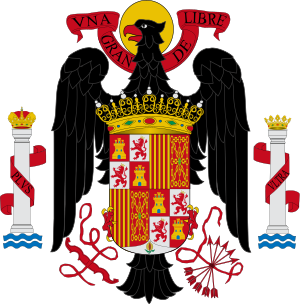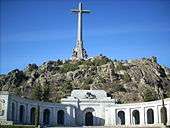National Catholicism
National Catholicism (Spanish: nacionalcatolicismo) was part of the ideological identity of Francoism, the political system with which dictator Francisco Franco governed Spain between 1939 and 1975. Its most visible manifestation was the hegemony that the Catholic Church had in all aspects of public and private life. As a symbol of the ideological divisions within Francoism, it can be contrasted to National syndicalism (Spanish: nacionalsindicalismo), an essential component of the ideology and political practice of the Falangists.


| Part of a series on |
| Francoism |
|---|
 |
|
History
In the 1920s France, a similar model of National Catholicism was advanced by the Fédération Nationale Catholique formed by General Édouard Castelnau.[3] Although it reached one million members in 1925, it was of short-lived significance, subsiding into obscurity by 1930.[4]
In Spain, the Francoist State initiated a project in 1943 to reform the university. It was called the University Regulatory Law (U.R.L.), which remained active until 1970.[5]

The U.R.L. represented the clearest politicization of the university in the service of the new regime's National-Catholic precepts. While there was no explicit exclusion of women from higher learning, their presence at the university level was discouraged and not recognized during the two first decades of the regime.[5]
In the 1930s and 1940s, Ante Pavelić's Croatian Ustaše movement espoused a similar ideology,[6] although it has been called other names, including "political Catholicism" and "Catholic Croatism".[7] Other countries in central and eastern Europe where similar movements of Francoist inspiration combined Catholicism with nationalism include Austria, Poland, Lithuania and Slovakia.[8]
See also
References
- "El Valle de los Caídos explicado a quienes no saben qué es". 8 May 2017.
- "World's Top 19 Largest Crosses (Reach High for the Sky!) - Miratico". 3 April 2015.
- Frank Tallett (2003). Catholicism in Britain & France Since 1789. Continuum International Publishing Group. pp. 152–154. ISBN 978-1-85285-100-2.
- Maurice Larkin (2002). Religion, Politics and Preferment in France since 1890: La Belle Epoque and its Legacy. Cambridge University Press. p. 157. ISBN 978-0-521-52270-0.
- Victoria Lorée Enders; Pamela Beth Radcliff (1999). "Gender Relations in the Francoist University". Constructing Spanish Womanhood: Female Identity in Modern Spain. SUNY Press. p. 59. ISBN 079144029X.
- Stanley G. Payne (1996). A History of Fascism, 1914–1945. University of Wisconsin Pres. p. 406. ISBN 978-0-299-14873-7.
- John R. Lampe (2004). Ideologies and National Identities: The Case of Twentieth-Century Southeastern Europe. Central European University Press. p. 102. ISBN 978-963-9241-82-4.
- Stanley G. Payne (1984). Spanish Catholicism: An Historical Overview. Univ of Wisconsin Press. p. xiii. ISBN 978-0-299-09804-9.
- BOTTI, Alfonso, Nazionalcattolicesimo e Spagna nuova (1881–1975), Milano, Franco Angeli, 1992 ISBN 88-204-7242-2 (Spanish trans. Cielo y dinero. El nacionalcatolicismo en España (1881–1975), Madrid, Alianza Editorial, 1992 ISBN 84-206-2717-8)
Further reading
- Stanley G. Payne (1984). "7. National Catholicism". Spanish Catholicism: An Historical Overview. University of Wisconsin Press. ISBN 978-0-299-09804-9.

